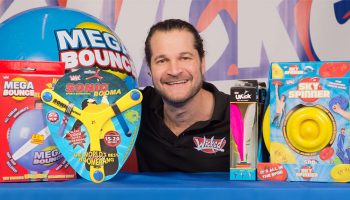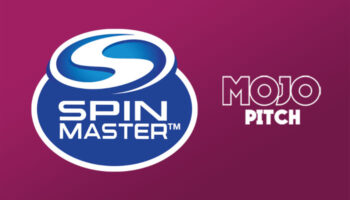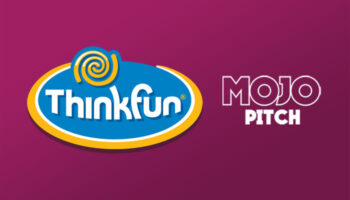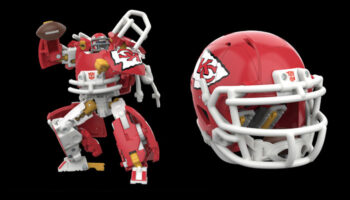Pat Marino on what makes a hobby game right for The Op

Pat, it’s great to catch up. To kick us off, what defines a ‘hobby game’ for you?
For the broader industry, what defines a hobby game is shifting… It’s quite hard to pin it down. When I started, there were a few clear areas – ‘this is Ameritrash’, ‘this is Euro’, ‘this is hobby’, ‘this is mass market’… Now, you’ve got Wingspan in Target, so there’s a blurring happening.
Some people say “If it’s a Vital Lacerda game that takes three hours to play and 90 minutes to learn, that’s a real hobby game!” Others will describe gateway games like Cascadia and Azul as hobby games.
It’s a minefield!
It is! But things get more refined if you look at what makes something a hobby game for The Op. When we went to our studio model – where we have a hub for party games, a hub for co-branded games, and a hobby hub – part of my job was to define what hobby meant for The Op. It’s easier to do that because it’s easier to define what it’s not. For example, if I were to release Vital Lacerda’s next heavy hobby game, a lot of people would scratch their heads and say “Huh?” It doesn’t feel like an Op game.
We’ve taken a different approach to hobby, and it’s not dissimilar from the sort of messaging you’re seeing from someone like Hasbro right now. We’re targeting a customer that I like to call ‘The Hobby Ambassador’.
‘The Hobby Ambassador’. Can you talk me through that?
They are the folks among us who are paying attention to games, buying and collecting games – but they’re looking for games they can bring to any of their gaming groups. For us, it’s important that this kind of game has a low barrier to entry in terms of rules and a really approachable theme. It’s a title you can bring to a game night with a group of friends who are happy to play games but might not buy lots of games.
If you’re the games sommelier for the evening, you can put this game down and your friends will look at the box art and the components and they’re interested – they want to play. It can’t be a faded beige ‘classic’ looking game.
Does that extend to gameplay? Simple, but with interesting decisions?
Yes! It should be a case of: Here’s what you can do on your turn… This, or this, or this. And everyone has got it. It’s intuitive and matches the theme. And then after a turn or two, something clicks… Oh wait a minute, there’s a lot of depth here! If I do this thing, it sends me this way and triggers this combo, but if I do these other things, it does this… That helps gateway gamers feel super clever.
They were invested in the theme, art, and components initially, but now they’re strategically invested and want to keep playing. That is the sweet spot for a hobby game for us.
Fantastic insights Pat, thank you for that. Are there any other requirements designers should bear in mind?
Usually, I’m looking for a 30 to 60-minute playtime. We want to keep the price point no more than $50 – if we can get it lower, that’s a benefit. We want to give these ‘Hobby Ambassadors’ the ultimate win, where at the end of the night, someone at the table says “Where did you get this? Where can I get this?” That’s the best feeling you can have as the host of a game night. You’ve shared and spread the hobby.
Great answer. Diving deeper into themes, are you presented with more interesting themes from designers these days?
I’m seeing more and more interesting themes. Sometimes I’ll see a great mechanic, but the theme is too familiar – it’ll be a forest or nature game… And something like a dark deep space game isn’t always the sort of thing a Hobby Ambassador can throw on the table for that kind of game night. Especially when compared to something like the colourful Azul or Everdell with its anthropomorphic animals.
Sometimes it’s more about tweaking mechanics to make them more intuitive to an exciting theme we haven’t seen before. But what I’m asking for is a tall order. I want originality and approachable, intuitive gameplay. It’s hard to do that. And when those games pop up, we’re not the only publisher trying to get them. It’s pretty competitive.
Approachable, intuitive gameplay… That’s also a requirement for several mass market categories like party games or family games. Do you think more mass-market designers should dip a toe into the hobby space?
To a point. When we look at hobby stuff, the experienced designers tend to want to go bigger. They enjoy the challenge of doing the next big heavy complex thing – which isn’t for us! And you actually get a lot more wiggle room in a design like that. If you’ve got 17 mechanics in your game, they don’t all have to be perfect for the game to still work.
But when you’re doing a mass market party game, you have two, maybe three rules! They all have to be elegant and perfect! You have to teach it to a group of adults who might be one beverage into the evening and chatty… If you can’t get that group to grasp the game fast, it’s probably too complex for that mass party space.
If a designer can take the elegance of a mass party game and add a dimension of strategy to it – some meaningful decision-making – that would be the key. You want the choices you make to feel like they have a lot of meaning and consequences. Sometimes I’ll see one element in a hobby game and I’ll say: “That! That’s the whole game! Cut all this other stuff around it and you might have an elegant gateway game here that people will gravitate towards.”
I want to loop back to themes for a moment. What kinds of themes do resonate for The Op?
We sometimes see themes that we’ve never seen before, and that’s exciting. And we sometimes see themes that we’ve never seen before, and I can’t market it. There’s a balance. Wingspan is a great example. Prior to that, there hadn’t really been a birdwatching game. That might’ve been a strange theme to some, but the art execution and the table presence made it so inviting and engaging.
We see a lot of space games and high fantasy. There’s still a huge audience for that type of stuff, but for our audience, we’re looking for something that’s broader and more accessible. Outside of the ‘nerdom’, there’s a view that sci-fi or fantasy stuff will be heady and complex, and so it’s hard to make that feel gateway.
One thing we see a lot of is trend-chasing. After Wingspan, a bunch of people tried to do bird games. Then you had Cascadia, Parks, and a lot of other games that embraced a broader nature theme. Now we’re seeing nature game after nature game after nature game… We’re talking in April, and I’ve seen around 415 submissions so far this year.
Crikey.
Yeah, it’s a lot! And of those, a good number have been a twist on the forest or nature theme. To stand out as a nature game, I’ve got to be confident that it’s going to outperform Cascadia and Parks – games that are entrenched in the market. That’s hard to do. I’m often looking for something with a hook, a twist, a new theme – and that’s hard to do sometimes without going too weird!
There are a few games floating around in the inventor community that are great, but struggle with that a little. There’s one centered on lab rats in a maze. It’s a compelling game but lab rat testing is not a feel-good theme, especially when the market has a lot of demand for cozy games right now.
How straightforward is it to change a designer’s theme if you like the mechanics?
There’s a lot of conversation in the inventor community around re-themes. I’ve heard people say: “Don’t worry about your theme because the publisher will change it anyway.” Others will say: “You need a theme and great artwork on your prototype to secure a publisher.” It really depends.
We see some games with themes that ‘work’, but it doesn’t work from a marketing standpoint. With that, we know a slight change could result in another theme working really well and giving it a broader, commercial appeal.
Then again, we’ve seen other games where you can’t change the theme without taking the whole game apart… Sometimes theme and mechanics are so infused together, it has to be what it is. But that can be a powerful thing if the theme works because it makes the game intuitive and easier to learn.
It’s ultimately a balance, but if we’re doing something based on an IP, we’re all in on the theme. Every decision around mechanics comes back to what the game has to achieve thematically.
On the licensed game front, do see potential for more brands to do exciting things in the hobby space?
A lot of people see us an IP-driven games company, especially due to our co-branded work with Hasbro. In the hobby space, we’re exploring things, but we are dialing back the number of signature IP games that we do.
We’ve found that some IP has a set shelf life; some brands don’t have the evergreen potential in the hobby market to justify a contract renewal. When you look at evergreen titles in the hobby space, they’re not IP games – other than a few games centered around Star Wars and The Lord of the Rings. We’re trying to be more intentional around where we dedicate our efforts in this area.

Harry Potter Hogwarts Battle is a good example of what works. That came out in 2016 and we’re still selling it today. We have two expansions. And the work of our co-branded hub helps us test the waters. If we launch an IP version of Clue and it does really well, that’s an indication that there’s a hunger for that brand in the board game space… That might suggest an appetite for a hobby game for that IP.
Let’s talk pitching. What makes for a successful hobby game pitch?
If we have a 30-minute pitch at something like Gen Con, and you want to show me two games, realistically we won’t set up, play and tear down two games in that time. We probably couldn’t do that with one game. Very quickly, it’s helpful to know the stats… How many players? How long does it take to play? What is the theme? Who am I? What am I doing? Why am I doing it? Then a top-level overview of how a game plays.
And what would you want in that overview?
Something like: ‘The game is this many rounds, and in each round, you take this many turns, and on your turn, you do this, this, and this.’ That gives me the flow of a game. The other thing that matters for me in a pitch is – what is the hook? What makes this special? For example, Dune Imperium and Lost Ruins of Arnak have that simple pitch – what if you take deck building and worker placement and put them together? You want to communicate that in a short amount of time.
And what’s next? What happens when you see something you like?
I’ll ask for a digital build or a print and play… Some type of prototype. And then I’ll play it with the team because you can’t get all the nuances of a game in a 30-minute pitch.

I wanted to ask about some recent hobby launches from The Op, starting with The A.R.T. Project. What made that appeal?
This was an import game that we partnered with Lumberjacks on and did the English language distribution for. You’ve got Vincent Dutrait art on that box and you go “What is that?” It’s an up to six-player co-op game that takes 30 to 40 minutes to play… Okay, so we’re talking high player count, short playtime, gorgeous art… And there are six different boards you can play – each with its own unique challenges. So there’s high replayability too.
Sounds like a winner!
Exactly, at a glance from that short pitch, it checks a lot of boxes. We’ve had a lot of success with co-op games at The Op so that appealed, and when you play it, the tension is just right. The way the difficulty ramps up is very intuitive too.

I’m sold! You also have AQUA. What can you tell us about that?
This is an interesting one. Brent Navratil – who is part of our sales team – saw this game at UK Games Expo. Brent brought it back and said: “I found this great hobby game”. Brent’s not a huge hobby gamer, so I was like: “Okay, sure Brent!” But it was exactly what we wanted!
Putting myself in the shoes of a hobby game ambassador, this is the type of game I would bring to Brent and say: “We should play this, I really think you’ll like it.” It came from the team at Sidekick and what they’re trying to do is so aligned with us. It’s been a great partnership and it won’t be the last time we collaborate with them.

Great stuff. Finally, Gnome Hollow… We interviewed the designer Ammon a while back – people can check that out here – but there’s a lot of excitement around this game.
Well, as your readers will know, the story behind the game is great and the watercolour artwork is so charming. We loved everything about it. It’s been a fantastic collaboration and is a major focus for us at Gen Con, alongside Stalk Exchange.

Stalk Exchange… This is the gardening-themed title?
Yes, it’s a game from Christopher Chan and it’s a stock market-style game themed around a floral garden. The market itself is a hex grid of planted flowers that are blooming and being harvested. All of the players are collectively manipulating that market while keeping their investment tokens hidden behind a screen. There’s a lot of that ‘I know that you know that I know’ stuff going on. There are some great puzzle aspects to it.
It looks beautiful too.
We brought in Diana Beltrán Herrera, a papercraft artist from the UK, to do the art. She created all of the floral elements, photographed them and we used those images in the game. That’ll launch at Gen Con.

Great. Is there anything we’ve missed that we should also draw folks’ attention to?
We also have Avatar: The Last Airbender – Aang’s Destiny out later this Fall. That’s one of my designs. It takes the strong points of the Harry Potter Hogwarts Battle engine and translates it to fit the Avatar brand – with some new elements. You play through the entire story from the first animated series. I was excited to work on this because I’m a huge Avatar fan.

Looks fun. Pat this has been great. I have one last question! In a crowded market, what helps a hobby game take off?
The first thing to say is that we want to find games that have that potential. We’re not going to do 10 games for the sake of doing 10 games… We might do four games because they are the titles we believe have that potential. The game has to have a hook; an easily conveyable magic. That needs to be backed by great art and great components, but for a game to take off it needs champions. Gnome Hollow has a lot of hype around because before we even signed it, it had a whole audience of champions rooting for it. So even on a small scale, I look for that.
For a community of fans supporting a title at that early stage?
Yes. I’ll even have inventors coming to me saying: “Have you played so and so yet? That game is special.” That’s a good indication that a game will do what it needs to do.
Terrific insights. Huge thanks again Pat.
–
To stay in the loop with the latest news, interviews and features from the world of toy and game design, sign up to our weekly newsletter here

























